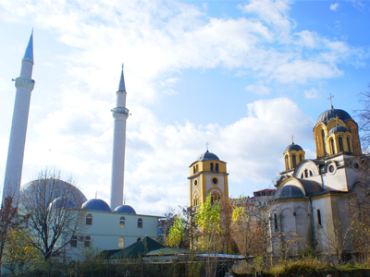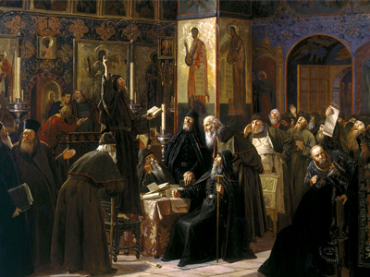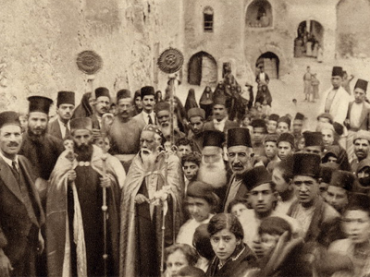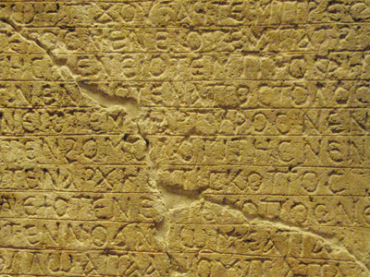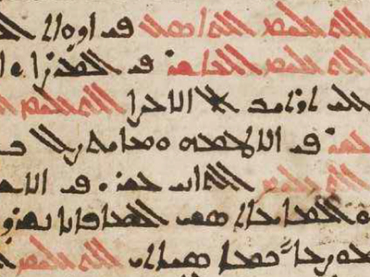Syriac and Eastern Christianity
Jacob of Sarug's Homily on the Fashioning of Creation (hardcover)
Edited and Translated by Edward G Mathews Jr
ISBN: 978-1-4632-4413-2
The long memra translated here in this volume presents the seven parts of the homily on Creation in a single volume.
$76.00
Jacob of Sarug's Homily on Aaron the Priest
Translation and Introduction by Kristian S. Heal
Series: Texts from Christian Late Antiquity 71
ISBN: 978-1-4632-4427-9
Jacob of Sarug's homily on Aaron the Priest, focusing on the period leading up to and including the death of Aaron described in Numbers 20:22–29.
$32.00
The Stanzaic Poems of Jacob of Serugh
A Collection of His Madroshe and Sughyotho
Series: Texts from Christian Late Antiquity 72
ISBN: 978-1-4632-4430-9
Although the verse homilies of Jacob of Serugh are well known to lovers of Syriac literature, his stanzaic poetry, in the form of madroshe and sughyotho, have been largely forgotten. This volume contains twenty-five poems preserved in their complete form and attributed to Jacob in old manuscripts of the sixth/seventh to ninth/tenth century preserved today in the British Library, but largely originating from Deir al-Surian in Egypt.
$59.00
Jacob of Sarug's Homily on the Love of God towards Humanity and of the Just towards God
Edited and Translated by Dominique Sirgy
Series: Texts from Christian Late Antiquity 74
ISBN: 978-1-4632-4432-3
Jacob of Sarug's homily chronicles the unravelling of God's love in sacred history and the inability of humankind to return God's love and grace.
$28.00
The Law Code of Īshōʿyahb I, Patriarch of the Church of the East
Edited and Translated by Amir Harrak
Series: Texts from Christian Late Antiquity 75
ISBN: 978-1-4632-4434-7
During the 6th century AD, Īshōʿyahb I, Patriarch of the Church of the East, produced a code of law dealing with questions raised by Bishop Jacob of Darai in the Gulf. Perennial Church issues include priestly conducts, ecclesiastical rankings, and ordinations. Legal matters for the faithful concern wills, marriages, vows, lending at interest, and swearing. Most interesting are names of church architecture that the Code gives, including bema, diaconicon, and qestroma, terms that are still used today.
$39.00
On This Day (August)
The Armenian Church Synaxarion (Yaysmawurkʿ)
Edited and Translated by Edward G Mathews Jr
Series: The Armenian Church Synaxarion 8
ISBN: 978-1-4632-4443-9
The Armenian Church Synaxarion is a collection of saints’ lives according to the day of the year on which each saint is celebrated. Part of the great and varied Armenian liturgical tradition from the turn of the first millennium, the first Armenian Church Synaxarion represented the logical culmination of a long and steady development of what is today called the cult of the saints. This volume, the first Armenian-English edition, is the eighth of a twelve-volume series—one for each month of the year—and is ideal for personal devotional use or as a valuable resource for anyone interested in saints.
$79.00
Medieval Encounters
Arabic-speaking Christians and Islam
Edited by Ayman S. Ibrahim; Contribution by Mark Beaumont, David Bertaina, Clint Hackenburg, Sandra Toenies Keating, Michael F. Kuhn, John C. Lamoreaux, Mourad Takawi, Jack Tannous, Alexander Treiger & Mina Yousef
Series: Gorgias Handbooks 55
ISBN: 978-1-4632-4447-7
A sourcebook of major Arabic Christian theologians and texts from the 9th-11th centuries. Christian authors who spoke and wrote Arabic had no choice but to engage with Islam and the complex realities of life—initially as a majority, later as a minority—under Muslim rule. They had to express their theology in new ways, polemicize against the claims of a new religion, as well as defend their doctrines against Islam’s challenges.
$55.00
ʿAmmār al-Baṣrī's Arabic Apologetics
The Book of the Proof concerning the Course of the Divine Economy and The Book of Questions and Answers
Translated by Mark Beaumont
Series: Gorgias Eastern Christian Studies 63
ISBN: 978-1-4632-4458-3
A new English translation of the two apologetic works by the 9th-century East Syrian theologian ʿAmmār al-Baṣrī. The Book of the Proof and The Book of Questions and Answers were written to defend Christian beliefs in the face of Muslim criticism.
$60.00 $48.00
Jacob of Sarug's Homily on Paul's Word to Seek What is Above and on Outer Darkness
Edited and Translated by Dominique Sirgy
Series: Texts from Christian Late Antiquity 76
ISBN: 978-1-4632-4464-4
Jacob of Sarug's homily on the Apostle Paul's advice to those who prioritise worldly matters, leading to an afterlife remote from God.
$25.00
The Syriac Orthodox Church in the Time of the Syriac Renaissance
In Concept and Reality
By Peter Kawerau; Translated by Patrick Conlin
Series: Gorgias Eastern Christian Studies 64
ISBN: 978-1-4632-4467-5
An English translation of the second edition of Peter Kawerau's Die Jakobitische Kirche im Zeitalter der syrischen Renaissance (1960).
$65.00
Jacob of Sarug’s Homilies on Abgar and Addai
Series: Texts from Christian Late Antiquity 77
ISBN: 978-1-4632-4469-9
Jacob of Sarug's homilies on King Abgar and the Apostle Addai, recounting the famous legend of Abgar of Edessa's conversion to Christianity.
$48.00
Jacob of Sarug's Homily Concerning the Red Heifer and the Crucifixion of our Lord
Edited and Translated by Demetrios Alibertis
Series: Texts from Christian Late Antiquity 78
ISBN: 978-1-4632-4471-2
Jacob of Sarug's homily on the red heifer slaughter ritual in Numbers 19. For Jacob, the narrative is a prefigurement of Christ's death and its ability to restore and permanently purify all who enter the church through baptism.
$28.00
Shiʿite Rulers, Sunni Rivals, and Christians in Between
Muslim-Christian Relations in Fāṭimid Palestine and Egypt
By Steven Gertz
Series: Islamic History and Thought 32
ISBN: 978-1-4632-4473-6
A historical study of the Fāṭimid caliphate in Palestine and Egypt during the fourth/tenth and fifth/eleventh centuries.
$95.00 $76.00
Shbītho
Monastic prayers from the Syriac tradition
Translation and Introduction by Dominique Sirgy
Series: Texts from Christian Late Antiquity 79
ISBN: 978-1-4632-4475-0
The Shbītho d-Dayroye is a thirteenth-century anthology dedicated to the personal prayer of monks and nuns. The collection comprises the writings of great saints in the Syriac Orthodox tradition including Ephrem the Syrian, Abraham Qidun, John Chrysostom, Gregory of Nazianzus, Philoxenos, Basil the Great, and Isaac the Syrian. For each of the seven daily prayer times (morning, third hour, noon, ninth hour, evening, and night), there is a main prayer and a closing prayer. The present edition is the first translation to make the spiritual treasures of the original Syriac text available to readers in English.
$45.00
The New Testament in Syriac. Peshitta Version
Paul
ISBN: 978-1-4632-4479-8
More than one hundred years after the publication of the BFBS volume of the Peshitta NT (1920), a critical edition of the Praxapostolos is still a desideratum. This edition fills the gap for the Corpus Paulinum. It expands the collations of the Scottish scholar John Pinkerton (1882–1916) up to some 60 manuscripts, incl. 5 lectionaries and 7 ‘masoretic’ manuscripts; it is based on the (slightly modified) BFBS text, which was established by the majority vote of Pinkerton’s collated manuscripts. The present edition turns the editorial principle of ‘majority vote’ into a textual history, considering the East-West-bifurcation of textual traditions, and the development of the Textus receptus by standardization. 9 printed editions are included, among which are 6 of the Textus receptus (incl. the editio princeps of 1555), thus covering the transmission of the Corpus Paulinum from the beginnings up to the 16th century.
$156.00
The Martyrdom of Mar Grigor Piran-Gušnasp and The Martyrdom of Mar Yazd-panah
Translation and Introduction by Florence Jullien; In Collaboration With Adam H. Becker
ISBN: 978-1-4632-4487-3
In the mid-6th century, Grigor, the general of the Sasanian king’s armies and a converted from Zoroastrianism to Christianity, was put to death. This event brings about the conversion of several Zoroastrian notables such as Yazd-panāh, a judge who also died as a martyr three years later, and the courtier ʿAwira. The reign of King Khusrō I (531–579) was a key-chapter in the history of the Persian Empire, but also for the Church of the East, some members of which were involved in the Sasanian administration. These East-Syrian historical texts, which are among the few passions of this period in Syriac, have received little scholarly attention. This volume offers a critical text and commentary, as well as the first translation into English of these two martyr texts. Written by contemporaries, they provide valuable information regarding socio-religious life and the political context. They demonstrate how Persian Christians, despite sporadic persecution, were able to maintain a distinct identity while simultaneously acculturating to the norms of Iranian society.
$75.00 $60.00
The Tale of Peter Rabbit in Classical Syriac
Translated by George Anton Kiraz
Series: Gorgias Handbooks 56
ISBN: 978-1-4632-4485-9
The Tale of Peter Rabbit in Classical Syriac is a retelling of Beatrix Potter’s classic tale for students of Classical Syriac as well as heritage readership. The vocabulary and expressions woven by George Kiraz draw not only on the language of the Peshitta Bible, but also on the language used in other texts, especially tales and colophons. Partially vocalized, the text aims to be readable to students of the language after completing a semester at the university level.
$28.00
A Reader in Syriac Based on the Entertaining Stories of Gregory Bar ʿEbrāyā
Series: Gorgias Handbooks 57
ISBN: 978-1-4632-4489-7
Thirty short reading selections from the Book of Entertaining Stories of Gregory Bar ʿEbrāyā, with an analysis of the grammar and vocabulary of the texts.
$47.50 $38.00
Journal of the Canadian Society for Syriac Studies 22
Edited by Amir Harrak
ISBN: 978-1-4632-4491-0
A refereed journal published annually by the Canadian Society for Syriac Studies.
$75.00 $60.00
Šalmūtā Šapīrtā
Festschrift for Rifaat Y. Ebied in honour of his contributions to Semitic Studies
Edited by Erica C. D. Hunter
Series: Gorgias Eastern Christian Studies 65
ISBN: 978-1-4632-4541-2
A Festschrift for Rifaat Ebied celebrating a lifetime of work in the field of Semitic Studies, in particular Syriac, Christian Arabic, and Mandaic.
$140.00 $112.00
The Syriac Orthodox in North America (1895–1995) / السريان في أمێركا الشمالية (Arabic Edition)
تاريخ موجز
By George Anton Kiraz; Translated by Hilal Mohammad Al-Jihad
Series: Gorgias Handbooks 59
ISBN: 978-1-4632-4545-0
An Arabic translation of George Anton Kiraz's 'The Syriac Orthodox in North America (1895–1995)' – a short history of the Syriac Orthodox community in North America between 1895, the year of the First Sayfo that triggered the first wave of immigration to North America, and 1995, marking the passing away of Metropolitan Mor Athanasius Yeshue Samuel, the first and only Archbishop of the Syriac Orthodox Archdiocese of the United States and Canada.
$42.00
Sacred Space in Syriac Orthodox Liturgy
A Ritual and Theological Perspective
Series: Gorgias Eastern Christian Studies 66
ISBN: 978-1-4632-4555-9
A study of how the Sedrō of Entrance has been practiced in earlier periods and architectural contexts and to investigate what role the entrance rite may have had in constructing the sanctuary as sacred space and the worshipping community as church.
$95.00 $76.00
Three Persian Martyr Acts
The Acts of Miles, Bishop of Susa, the Priest Abursam, and Deacon Sinai, The Martyrdom of Zebina and his Companions, and The Martyrdom of the Forty Martyrs of Beth Kashkraye
Edited with an Introduction by Susan Ashbrook Harvey, Professor Reyhan Durmaz, Michael L. Payne, Prof. Daniel Picus & Noah Tetenbaum
ISBN: 978-1-4632-4561-0
This volume brings together the texts and translations for three Syriac martyr acts, set in Sasanian Persia during the reign of Shapur II (309-379 CE). These texts offer compelling witness to the challenges of a community’s need to honor memory and experience, and evidence towards the formation and sustenance of Christian identity in the midst of Persian society and culture.
$74.00 $59.20
New Syriac Primer (Fourth Edition)
Series: Gorgias Handbooks 60
ISBN: 978-1-4632-4568-9
The Fourth Revised Edition of George A. Kiraz's Syriac Primer.
$48.00
Identity and Witness
Syriac Christians of the Middle East and India between homeland and global presence
Edited by Dietmar W. Winkler and Andreas Schmoller
ISBN: 978-1-4632-4570-2
Identity has become a central theme in a globalised world, both in politics and in the humanities, and the Syrian churches cannot escape it either. Christianity also exists as an identity that can in some ways compete with or even contradict theological understandings as a witness. But how should religious leaders deal with the fact that their churches are as much faith communities as identity markers? This volume does not offer the all-encompassing answer to this central question, but it provides keys for reflection and discussion beyond the circle of clergy and theologians, showing why the Syriac tradition matters for global Christianity. With contributions by Naures Atto, Bishop Anoine Audo SJ, Sebastian Brock, Mar Theophilose Kuriakose, Archbishop Paul Matar, Philip Nelpuraparambil, Andreas Schmoller, Baby Varghese and Dietmar W. Winkler.
$95.00 $76.00
Filter by
Filter by price
Filter by manufacturer

